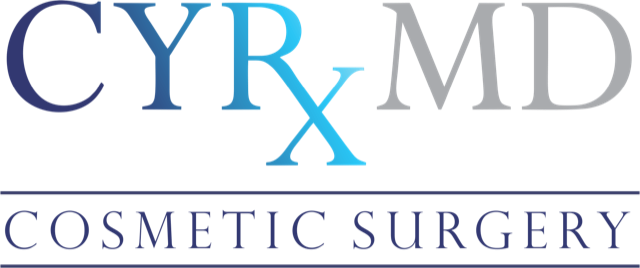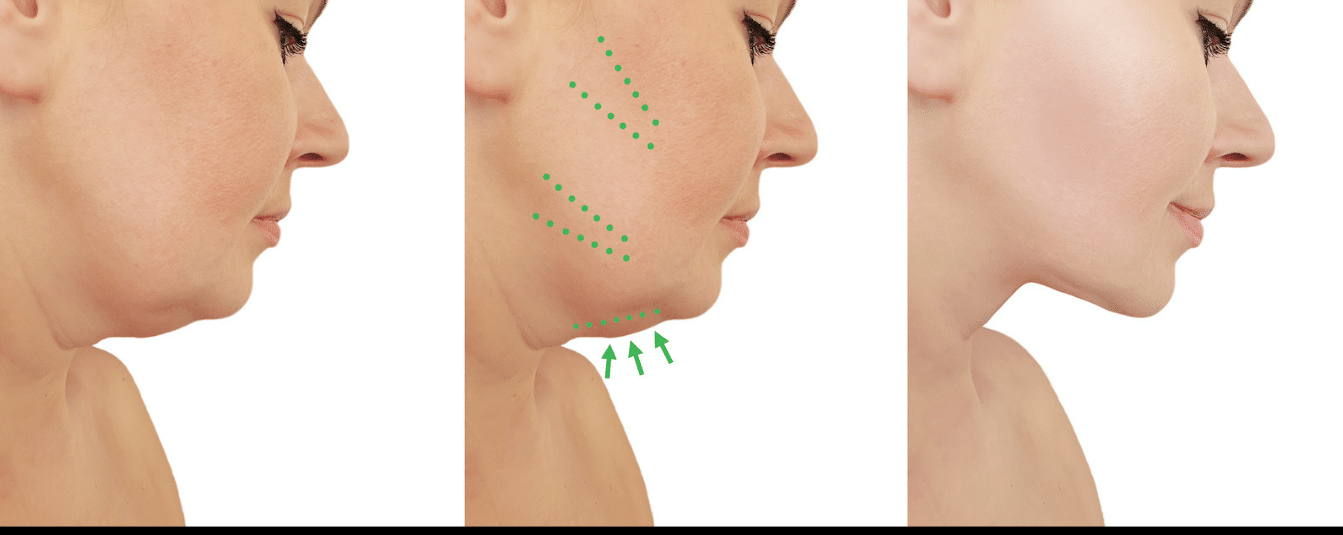Houston Facelift Overview
A facelift (rhytidectomy) is a cosmetic surgical treatment that makes your face and neck younger. The procedure can decrease drooping or folds of skin on the cheekbones and jawline and lift the neck in the case of a full facelift. It addresses age-related changes in the contour of your face from the neck to the mid-face.
During a facelift, the skin on each side of the face is pulled back, muscle tissue below the skin is surgically altered to return the contour of the face to a more youthful shape. Before the flap sutured closed, excess skin gets removed. Dr. Cyr may also use Renuvion radiofrequency to tighten your skin.
A facelift often requires some skin removal to produce the best results. A talented surgeon will apply just the right amount of skin and muscle tension to create a more youthful, natural appearance without the over-stretched or wind-blown look that says, “I had a facelift!.” Not with the Houston Facelift!
Note: a facelift will not significantly reduce fine creases or wrinkles in your skin, nor will it reverse sun damage. Other cosmetic treatments, like laser and chemical peels, can improve the look or quality of the skin.
A neck lift is frequently performed in conjunction with a facelift to remove fat deposits and drooping skin on the neck.
Types of Facelifts
Facelift surgery individualizes to a patient’s needs, and as a cosmetic surgeon, Dr. Cyr has the skills to tailor their techniques accordingly.
Of note, is that Dr. Cyr brings superior understanding to the musculoskeletal structures of the face with his OrthoSculptÔ approach that he coined the “Houston Facelift”.
Mini-Facelift
Patients with moderate jowling and sagging skin are frequently suitable candidates for a mini-facelift. A mini-facelift is a minimally invasive procedure that allows a cosmetic surgeon to tighten deep facial tissues using small incisions, generally positioned along the hairline above each ear and in the natural creases surrounding the ear. Through these incisions, structural tissues surrounding the cheeks are raised and tightened to address jowling, improve the jawline, and revitalize a “tired” look.
Depending on the circumstances, a mini-facelift may perform under local anesthetic with sedation or under general anesthesia; your cosmetic surgeon will advise you on the best choice for your specific needs. A mini-facelift can help you address unwanted symptoms of aging before they become too noticeable, delaying the need for more substantial surgery for several years.
Standard Facelift
A conventional or “classic” facelift will thoroughly address moderate to advanced aging around the mid-face and neck. While the procedure is more thorough than a mini-facelift and requires more recovery time, the results are more striking. A cosmetic surgeon can rearrange the deeper tissues beneath the skin and remove extra skin through incisions below the hairline to smooth wrinkles, reduce jowling and sagging skin under the chin, and restore a naturally young shape to the face and neck.
The SMAS Facelift – The Gold Standard
Your facial skin begins to age, and there is a loss of elasticity in the epidermis and the SMAS membrane. This loss results in sagging cheeks along the jaw bone, creating fleshy jowls and often a double chin. Cheek fat will then sag forward to increase the appearance of the nasolabial folds.
A SMAS facelift reduces the appearance of aging by tightening the muscle, eliminating or replacing fat as needed, and cutting away extra skin. A SMAS facelift can help you with the following issues:
- Sagging in the midface
- Neck laxity and sagging skin
- Hollow cheeks
- Jowls
- Nasolabial folds
- Sagging fat
- Eliminate loose skin and fat under the chin
A facelift will remove or reduce the signs of aging but, over time, they will gradually reappear. Talk to your surgeon about the best way to maintain your investment over the years.
How To Prepare For Your Facelift
You’ll first consult with a cosmetic surgeon about a facelift. The appointment will most likely include a medical history and examination. Prepare to answer questions regarding your present and previous medical issues, previous surgeries, previous cosmetic operations, complications from previous procedures, smoking history, and drug or alcohol usage. If your surgeon has any reservations about your surgery, they may ask you to have a physical exam, seek current records from your doctor, or arrange for a meeting with a specialist.
Medication evaluation. Give the names and amounts of all medications you use daily, including prescription pharmaceuticals, over-the-counter medications, herbal medicines, vitamins, and other dietary supplements.
Tests. Your surgeon’s office will give you an order for a blood test to confirm your status as non-anemic, verify you have no nicotine in your system, and ensure you have no active infections. Your surgeon may ask you to get other tests, such as a COVID test, within a few days of your surgery.
Facial exam. Your cosmetic surgeon will take images of your face from various angles as well as close-ups of certain features. To identify your best alternatives for facelift surgery, the surgeon will also analyze your bone structure, face shape, fat distribution, and skin quality.
Expectations. Your surgeon will inquire about your hopes for the results of a facelift. Dr. Cyr will help you understand how a facelift will likely change your appearance and what a facelift doesn’t address, such as fine wrinkles or naturally occurring asymmetry in your face. However, in some cases, asymmetry can be addressed and may be more corrective than cosmetic surgery.
Before a Facelift:
Follow the instructions on what medicines to take. You will receive advice on which drugs to discontinue and when to finish them. For example, you will get advised to stop taking any blood-thinning medicine or supplement at least two weeks before surgery. Consult your doctor about which drugs are safe to use and whether the medication should adjust the dosage of any medicines.
Wash your face and hair. You’ll likely ask to wash your hair and face with germicidal soap the morning of the surgery. You’ll ask to avoid eating anything after midnight the night before your facelift. You can drink water and take medications that your surgeon has approved.
Make arrangements for assistance during your recovery. If your facelift performs as an outpatient treatment, arrange for someone to drive you home following surgery and to remain with you the first night.
Risks
Complications from facelift surgery are possible. Risks can manage with adequate care, medicine, or the rare surgical correction after a facelift. While long-term or permanent problems are uncommon in the hands of the right surgeon, they might result in dramatic alterations in appearance.
The risks include:
- Hematoma. A blood (hematoma) collection under the skin that causes swelling and pressure is the most common complication of facelift surgery. Hematoma formation, which usually occurs within one day of surgery, is treated promptly to prevent damage to the skin and other tissues.
- Scarring. Facelift incision scars are permanent. However, they are hidden in the hairline and natural curves of the face and ear. Incisions can occasionally result in elevated red spots, which tend to flatten over time. Corticosteroid injections or other therapies, like a laser, may minimize the look of scars.
- Nerve injury. Nerve damage, while uncommon, can have a temporary or permanent effect on nerves that regulate sensation or muscles. A feeling of numbness in a small area is one of the types of nerve injury.
- Hair loss. Hair loss at the incision sites may be transient or permanent. You addressed temporary hair loss by undergoing surgery to implant skin containing hair follicles.
- Skin loss. Rarely, a facelift can interrupt the blood supply to your facial tissues. You can treat this with medications, appropriate wound care, and a procedure to minimize scarring if necessary.
- Like any other major operation, a facelift has the risk of bleeding, infection, and an inadequate response to anesthesia.
Some medical issues and lifestyle choices might also raise your risk. The following factors may pose a substantial risk or result in poor outcomes, and your doctor may advise against undergoing a facelift or tell you to discontinue controllable risk factors:
- Blood-thinning medications or supplements might impair your blood’s capacity to clot and raise your risk of bleeding and/or the formation of hematomas following surgery. Examples are blood thinners (Coumadin, Plavix, others), aspirin, nonsteroidal anti-inflammatory medicines (NSAIDs), ginseng, Ginkgo biloba, fish oil, and other supplements.
- Pre-Existing Conditions
- Medical problems. You will not get a facelift if you have a medical issue that inhibits blood clotting. Other diseases, such as poorly managed diabetes or high blood pressure, raise the risk of poor wound healing, hematomas, and cardiac problems. If you have had a stroke or have a heart condition or uncontrolled high blood pressure, you may not be a candidate for cosmetic surgery, especially in the neck area.
- Smoking. After a facelift, smoking increases the risk of poor wound healing and more pronounced bruising dramatically. If you are a smoker, your surgeon will require you to quit for at least 60 days before the surgery and will most likely test your blood for the absence of nicotine as a precaution for your safety.
Choosing a Cosmetic Surgeon
Facelift surgery is a complex operation requiring considerable expertise with the anatomical structure of the face, specific surgical procedures, and a highly developed aesthetic eye. Because not all cosmetic surgeons undergo facelift surgery training during their residency, it’s critical to conduct your research before selecting a facelift surgeon.
Inquire about a potential cosmetic surgeon’s specialized training and experience before meeting with them. You should be aware of the number of facelift operations conducted by the surgeons, and you should look at before and after photographs during your appointment. You may get a sense of a cosmetic surgeon’s aesthetic approach by looking at before and after photos.
Men seeking facelift surgery should ensure that the cosmetic surgeon has performed facelifts on male patients; the structure of the male face differs from that of a woman’s and necessitates a varied approach.
Dr. Cyr brings an unparalleled understanding of the muscular structure of the body and face. The precision he brings to cosmetic surgery was honed doing delicate spine surgeries for many years. His talent for picturing the muscular in 3D brings a unique skill to his facelift procedures.
What’s Next?
The Houston Facelift with OrthoSculpt necessitates a personalized surgical plan. That starts with a consultation with Dr. Cyr.
Fill out our contact form here to take your next step here or better yet, call today! 1 (833) CHISEL U | (833-244-7358).




